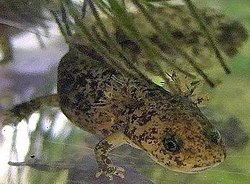| Hynobius | |
|---|---|
 | |
| Hynobius fossigenus | |
| Scientific classification | |
| Kingdom: | Animalia |
| Phylum: | Chordata |
| Class: | Amphibia |
| Order: | Urodela |
| Suborder: | Cryptobranchoidea |
| Family: | Hynobiidae |
| Subfamily: | Hynobiinae |
| Genus: | Hynobius Tschudi, 1838 |
Hynobius is a genus of salamander (Asian salamanders) in the family Hynobiidae, occurring in Japan, Korea, China, Taiwan and Far East Russia. It is a large genus containing over 40 species. [1] The Japanese archipelago is the primary diversity hotspot for the genus, with nearly 67.3% of Hynobius species being endemic to it. [2]
